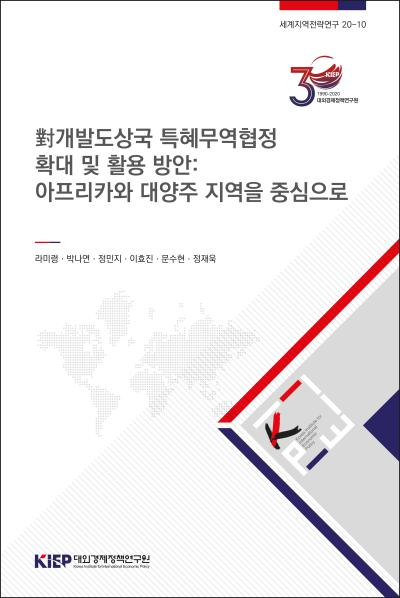Working Papers
PUBLISH
Working Papers
To list

Korea’s Strategy on Trade Agreements with Developing Countries in Africa and the Pacific Regions
Author Meeryung La, Nayoun Park, Minji Jeong, Hyo Jin Lee, Soo Hyun Moon, and Jae Wook Jung Series 20-10 Language Korean Date 2021.04.30
Africa and the Pacific regions (AP) have been excluded from Korea's FTA network despite their high market potential and strategic importance. Most countries in the AP region are developing countries, and Korea has approached this region only from the perspective of development cooperation, while economic cooperation in the AP region remains limited to corporate participation or small-scale investment in individual countries. Current trade agreements and systems are insufficient to expand trade and investment with Africa and the Pacific Islands.
Against this backdrop, this study seeks mid- to long-term trade cooperation measures with nations in Africa and the Pacific Islands. Given that most of these countries are developing and least developed, we consider introducing and expanding non-reciprocal trade agreements that provide unilateral trade benefits, and introducing reciprocal trade agreements. According to the results of this study, it is necessary to establish comprehensive FTAs, i.e. mutual trade agreements, that can strengthen the trade capacity of the partner countries. However, as the FTAs signed by Korea up to now are not suitable for the AP region, where substantial regulations are prevalent for the economic development of each country, we additionally propose a new FTA model and utilization measures for the region.
Currently, Korea has granted Duty-Free Quota-Free (DFQF) access to least developed countries, and exempted tariffs on about 95% of imported products from least developed countries since 2012. However, imports from least developed countries still account for less than 1 percent of Korea's total imports. Imports from least developed countries tend to be concentrated in a small number of industries, with ASEAN countries accounting for a significant portion of imports from these countries.
The non-reciprocal trade agreements Korea has implemented for least developed countries have been found to lack in their effect toward expanding trade and investment between two countries. They also have certain limitations, such as beneficiary sectors being limited to the product sector, and how beneficiary countries can change depending on the domestic situation of the donor country. On the other hand, the results of the empirical analysis in Chapter 4 show that unlike the DFQF scheme, Korea's FTAs have a significant and positive effect on trade. In conclusion, Korea would benefit from establishing comprehensive and sustainable economic cooperation channels by pursuing a mutual trade agreement, i.e. free trade agreement, with countries with high growth potential in Africa and the Pacific Islands.
Meanwhile, it is worth considering a step-by-step strategy when introducing preferential trade agreements with countries in the AP region. The United States institutionalizes dialogue channels by signing a Trade and Investment Framework Agreement (TIFA) before discussing trade negotiations with underdeveloped countries. Using a platform like the TIFA could be an alternative to consider when promoting trade cooperation with countries that have high potential for development but have not reached the stage of discussing market opening. In addition, it is necessary to pursue a multilateral FTA with the African Economic Community, as well as a higher level of bilateral FTA with major countries in the community. ODA agencies should be encouraged to participate in the process of reviewing and implementing FTAs, and to make efforts to enhance the link between trade and development cooperation. One way is to utilize the Country Partnership Strategy (CPS) in the FTA negotiation process.
Since the majority of countries in the AP region are developing and least developed countries, it is necessary to support the establishment of industrial and trade infrastructure in these countries to increase the demand for cooperation. In particular, the government should strengthen the efficiency of aid-for-trade by improving the link between trade and development cooperation. Investment or technological cooperation should be carried out in the “infant industries” of AP regions where positive learning spillover is expected, and in conjunction with this, mutual beneficial cooperation should be sought. Since this requires exchanges between private companies as well as consultations between the two governments, it will be important to establish a consultation system between the two governments and private companies.
Sales Info
| Quantity/Size | 211 |
|---|---|
| Sale Price | 10 $ |
 공공저작물 자유이용허락 표시기준 (공공누리, KOGL) 제4유형
공공저작물 자유이용허락 표시기준 (공공누리, KOGL) 제4유형
대외경제정책연구원의 본 공공저작물은 "공공누리 제4유형 : 출처표시 + 상업적 금지 + 변경금지” 조건에 따라 이용할 수 있습니다. 저작권정책 참조
